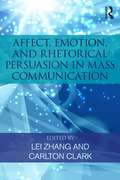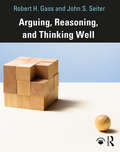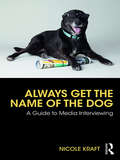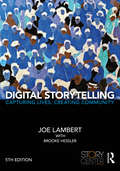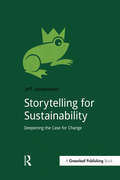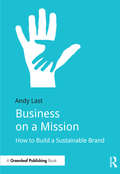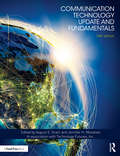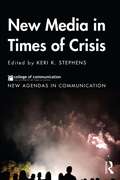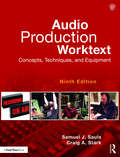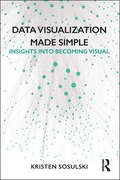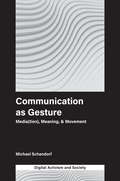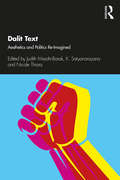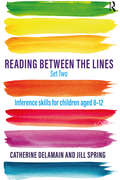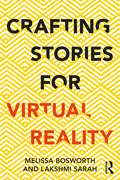- Table View
- List View
Affect, Emotion, and Rhetorical Persuasion in Mass Communication
by Lei Zhang Carlton ClarkThis volume examines the interplay between affect theory and rhetorical persuasion in mass communication. The essays collected here draw connections between affect theory, rhetorical studies, mass communication theory, cultural studies, political science, sociology, and a host of other disciplines. Contributions from a wide range of scholars feature theoretical overviews and critical perspectives on the movement commonly referred to as "the affective turn" as well as case studies. Critical investigations of the rhetorical strategies behind the 2016 United States presidential election, public health and antiterrorism mass media campaigns, television commercials, and the digital spread of fake news, among other issues, will prove to be both timely and of enduring value. This book will be of use to advanced undergraduates, graduate students, and active researchers in communication, rhetoric, political science, social psychology, sociology, and cultural studies.
Arguing, Reasoning, and Thinking Well
by Robert Gass John SeiterArguing, Reasoning, and Thinking Well offers an engaging and accessible introduction to argumentation and critical thinking. With a pro-social focus, the volume encourages readers to value civility when engaged in arguing and reasoning. Authors Gass and Seiter, renowned for their friendly writing style, include real-world examples, hypothetical dialogues, and editorial cartoons to invite readers in. The text includes a full chapter devoted to the ethics of argument, as well as content on refutation and formal logic. It is designed for students in argumentation and critical thinking courses in communication, philosophy, and psychology departments, and is suitable for students and general education courses across the curriculum.
Always Get the Name of the Dog: A Guide to Media Interviewing
by Nicole KraftAlways Get the Name of the Dog is a guide to journalistic interviewing, written by a journalist, for journalists. It features advice from some of the best writers and reporters in the business, and takes a comprehensive view of media interviewing across multiple platforms, while emphasizing active learning to give readers actionable steps to become great media interviewers. Through real scenarios and examples, this text takes future journalists through the steps of the interview, from research to source identification to question development and beyond. Whether you are a journalism student or an experienced reporter looking to sharpen your skills, this text can help make sure you get all you need from every interview you conduct.
Digital Storytelling: Capturing Lives, Creating Community
by Joe Lambert Brooke HesslerIn this revised and updated edition of the StoryCenter's popular guide to digital storytelling, StoryCenter founder Joe Lambert offers budding storytellers the skills and tools they need to craft compelling digital stories. Using a "Seven Steps" approach, Lambert helps storytellers identify the fundamentals of dynamic digital storytelling – from conceiving a story, to seeing, assembling, and sharing it. Readers will also find new explorations of the global applications of digital storytelling in education and other fields, as well as additional information about copyright, ethics, and distribution. The book is filled with resources about past and present projects on the grassroots and institutional level, including new chapters specifically for students and a discussion of the latest tools and projects in mobile device-based media. This accessible guide’s meaningful examples and inviting tone makes this an essential for any student learning the steps toward digital storytelling.
Intercultural Business Negotiations: Deal-Making or Relationship Building
by Jean-Claude UsunierNegotiations occupy a prominent place in the world of business, especially when it comes to international deals. In an increasingly global business environment, understanding and managing cultural differences is key to successful negotiations. This book highlights two basic components of negotiations: the Deal and the Relationship. Countries and cultures place different value and priority on these components both in the negotiation process and in the outcome. Intercultural Business Negotiations provides a guiding framework that is both refined and contextualized and provides managers with the key skills necessary to navigate difficult negotiations where partners may differ in terms of culture, communication style, time orientation, as well as personal and professional backgrounds. The book systematically examines both dispositional and situational aspects of negotiations in interaction with cultural factors. Intercultural Business Negotiations is an accessible resource for managers, leaders, and those interested in or studying business negotiations globally. It is accompanied by an author run companion website containing negotiation simulations, instructions for players, and teaching notes for instructors.
Creating a Culture of Integrity: Business Ethics for the 21st Century
by Andrea Spencer-Cooke Fran van DijkFor companies, unethical business practices like bribery and corruption pose major business risks, and can result in fines, reputational damage, lost business opportunity and – increasingly – criminal or civil charges.Organizations have responded to this critical governance issue with rigorous formal integrity and compliance frameworks, to set out and enforce standards for ethical business practice. But companies also need to create an enduring culture of integrity that establishes doing the right thing as the cultural norm across the organization – and this requires more than compliance alone.Creating a Culture of Integrity identifies the key actions sustainability and compliance officers can take to foster this cultural shift within their organizations.This "one-stop" toolkit for embedding integrity also includes: inspiring best-practice case studies from companies who’ve implemented culture change, with insights on how they deal with ethical dilemmas when these arise and; powerful arguments to help you make the business case for building a strong ethical culture around your compliance system.
Storytelling for Sustainability: Deepening the Case for Change
by Jeff LeinaweaverStorytelling is an ancient practice and a priceless skill. For sustainability practitioners who want to be more strategic and have more influence in shaping a better world, it is a crucial skill to master.In this short guide, veteran sustainability strategist and storyteller Jeff Leinaweaver shows you which ways of storytelling "transmit resonance" and lead to success and which lead to failure.You will learn techniques for using storytelling to attract attention and get better results, whether you are communicating statistics and priorities, advocating for change, organizing stakeholders, or building an authentic brand and community.Storytelling for Sustainability offers a comprehensive primer on storytelling and a range of insights and practical exercises, including: the failure of the sustainability story, discovering your passionate fact, your convenience story, reverse storyboarding, and what’s my storyline?
PR 2.0: How Digital Media Can Help You Build a Sustainable Brand
by John FriedmanDigital media offer many of the same characteristics – immediacy, transparency and interactivity – that make one-to-one the most effective form of communication. And yet many organizations do not fully embrace them. They simultaneously underestimate and fear the power of digital communications. And yet these tools, when used strategically, can be an effective part of your communications plan.PR 2.0 will help you: 1. understand how the increasing emphasis on transparency driven by corporate responsibility has changed the ways that effective organizations communicate with their stakeholders; 2. develop a communications plan for your organization that reaches, and engages, the right stakeholders, using the most appropriate tools and channels; 3. demonstrate the value and “sell” the use of digital media to skeptical internal stakeholders, including in the c-suite, as part of your mission-advancing communications plan. You can make the most of the irrevocable changes in the way people create, share, receive, judge and interact with information. This book offers real-world examples and practical tools to help your organization to live its values and effectively engage with those most essential to your success.
Business on a Mission: How to Build a Sustainable Brand
by Andy LastBronze winner of the AXIOM Business Book Award in the category of Philanthropy, Non-Profit, Sustainability. Please see: http://www.axiomawards.com/77/award-winners/2017-winners This easy-to-read and engaging book is the perfect introduction to how to build a sustainable brand for your organization. Intended as a roadmap that can be readily applied by busy managers and practitioners, the book includes interviews with business leaders, including Paul Polman of Unilever, Adam Elman of Marks & Spencer, and Jonas Prising of ManpowerGroup to provide insight into best practice and clear guidance for implementation. Throughout, the book avoids jargon and theorizing to ensure readability. Business on a Mission is based on more than a decade working with some of the first businesses to develop social missions and shows the foundations behind their success. It looks at how businesses can profit from working hand in hand with society and identifies a model for success. The book demonstrates how businesses can go from hiding behind "social shields" to picking up "social swords" and presents the six criteria to look for in assessing a social mission. It also focuses on how good communications can build trust and bring about positive change; and it provides clear ways to engage employees and improve productivity as well as "rules" for communicating social missions externally. This optimistic book explains the benefits of partnerships in the sustainable development agenda, particularly between businesses and NGOs. The book features guidelines for avoiding dysfunctional partnerships, and presents interviews with Marc Van Ameringen, Executive Director of GAIN (Global Alliance for Improved Nutrition) 2005 to 2016, and Myriam Sidibe, Social Mission Director for Africa, Unilever, on how things can be managed to the benefit of both partners. .
Communication Technology Update and Fundamentals: 16th Edition
by August E. Grant Jennifer H. MeadowsFor three decades, Communication Technology Update and Fundamentals has set the standard as the single best resource for students and professionals looking to brush up on how communication technologies have developed, grown, and converged, as well as what’s in store for the future. The secret to the longevity is simple—every two years, the book is completely rewritten to ensure that it contains the latest developments in mass media, computers, consumer electronics, networking, and telephony. Plus, the book includes the Fundamentals: the first five chapters explain the communication technology ecosystem, the history, structure, and regulations. The chapters are written by experts who provide snapshots of the state of each individual field. Together, these updates provide a broad overview of these industries, as well as the role communication technologies play in our everyday lives. In addition to substantial updates to each chapter, the 16th edition includes: First-ever chapters on Virtual/Augmented Reality and eSports. Updated user data in every chapter. Overview of industry structure, including recent and proposed mergers and acquisitions Suggestions on how to get a job working with the technologies discussed. The companion website, www.tfi.com/ctu, offers updated information on the technologies covered in this text, as well as links to other resources.
War Reporting and Justice (PDF)
by Slavko GajevicThis book explores how journalists understand and interpret justice in their coverage of wars. Its deep analysis of war reporting offers a new understanding of modern, multicultural societies in times of conflict. In particular, it explores how the Yugoslav conflicts of the 1990s gave birth to the modern notion of the transnational community. The text provides new theoretical concepts in order to better understand media work during times of war, and offers new definitions of conflict and the transnational community as an authority of normative criteria for justice. Furthermore, it details a new model for the analysis of media texts with step-by-step guidelines and examples that will be very useful for media educators, journalism teachers, and students of journalism. The books novel approach to understanding justice during a times of conflict will also be valuable for journalists who cover armed conflicts.
New Media in Times of Crisis (New Agendas in Communication Series)
by Keri K. StephensNew Media in Times of Crisis provides an interdisciplinary look at research focused around how people organize during crises. Contributors examine the latest practices for communicating during crises, including evacuation practices, workplace safety challenges, crisis social media usage, and strategies for making emergency alerts on U.S. mobile phones constructive and helpful. The book is grounded in the practices of first responders, crisis communicators, people experiencing tragic events, and communities who organize on- and offline to make sense of their experiences. The authors draw upon a wide range of theories and frameworks with the goal of establishing new directions for research and practice. The text is suitable for advanced students and researchers in crisis, disaster, and emergency communication.
An Integrated Approach to Communication Theory and Research (Routledge Communication Series)
by Don W. Stacks Michael B. Salwen Kristen C. EichhornThis new edition provides a comprehensive overview of current theory and research written by the top theorists and researchers in each area. It has been updated to address the growing influence of technology, changing relationships, and several growing integrated approaches to communication and includes seven new chapters on: ■ Digital Media ■ Media Effects ■ Privacy ■ Dark Side ■ Applied Communication ■ Relational Communication ■ Instructional Communication ■ Communication and the Law The book continues to be essential reading for students and faculty who want a thorough overview of contemporary communication theory and research.
Audio Production Worktext: Concepts, Techniques, and Equipment
by Samuel J. Sauls Craig A. StarkAudio Production Worktext, 9th Edition provides readers the best introduction to audio and radio production. It shows how to navigate modern radio production studios and utilize the latest equipment and software. The 9th edition is updated to cover new mobile technologies, digital consoles, and audio editing apps and software, as well sound for the visual media and Internet radio. The new edition continues to include the worktext/website format tailored for both students and teachers and features like Production Tips that provide notes relevant to various audio production topics, self-study questions and projects, an updated Glossary, and an up-to-date companion website with invaluable student and instructor materials. Included in this edition are offers and features from Pro Sound Effects, FilmTVsound.com, and RadioFX, as well as updated color graphics and images throughout the text.
Data Visualization Made Simple: Insights into Becoming Visual
by Kristen SosulskiData Visualization Made Simple is a practical guide to the fundamentals, strategies, and real-world cases for data visualization, an essential skill required in today’s information-rich world. With foundations rooted in statistics, psychology, and computer science, data visualization offers practitioners in almost every field a coherent way to share findings from original research, big data, learning analytics, and more. In nine appealing chapters, the book: examines the role of data graphics in decision-making, sharing information, sparking discussions, and inspiring future research; scrutinizes data graphics, deliberates on the messages they convey, and looks at options for design visualization; and includes cases and interviews to provide a contemporary view of how data graphics are used by professionals across industries Both novices and seasoned designers in education, business, and other areas can use this book’s effective, linear process to develop data visualization literacy and promote exploratory, inquiry-based approaches to visualization problems.
Communication as Gesture: Media(tion), Meaning, & Movement (Digital Activism and Society: Politics, Economy and Culture in Network Communication)
by Michael SchandorfWhile the concept of communication has long been bound to a reductive model of the exchange of information, very few scholars of communication would argue that these assumptions are realistic, without a long list of qualifying caveats. But the concept of communication, built from the integration of semiotic signification with the idea of information as the 'carrier' of transmitted meaning, is so deeply ingrained and simple that even displacing it can seem futile, if not absurd. Nevertheless, these foundational assumptions tightly constrain the ways in which any interactional phenomena can be conceived--and constraints upon our ways of understanding communication drastically limit our capacity to understand our worlds and the social processes that generate them, at any scale or level of abstraction. Communication as Gesture traces the concept of communication from its roots in classical rhetoric to its integration in structural linguistics, semiotics, information theory, and cybernetics, integrating perspectives from contemporary rhetorical theory, relational psychology, interactional sociology, philosophy, cognitive linguistics, discourse studies, multimodal semiotics, and more. Because so much of our contemporary world is lived with and through digital media technologies, the study of new media and social media provides a rich illustration of the constraints imposed by our reductive assumptions--and hints at the possibilities generated by rethinking them. The gesture theory of communication introduced presents a dimensional account of communication that is intuitively accessible and theoretically rich while overturning reductive assumptions of the linear character of interaction.
Communication as Gesture: Media(tion), Meaning, & Movement (Digital Activism and Society: Politics, Economy and Culture in Network Communication)
by Michael SchandorfWhile the concept of communication has long been bound to a reductive model of the exchange of information, very few scholars of communication would argue that these assumptions are realistic, without a long list of qualifying caveats. But the concept of communication, built from the integration of semiotic signification with the idea of information as the 'carrier' of transmitted meaning, is so deeply ingrained and simple that even displacing it can seem futile, if not absurd. Nevertheless, these foundational assumptions tightly constrain the ways in which any interactional phenomena can be conceived--and constraints upon our ways of understanding communication drastically limit our capacity to understand our worlds and the social processes that generate them, at any scale or level of abstraction. Communication as Gesture traces the concept of communication from its roots in classical rhetoric to its integration in structural linguistics, semiotics, information theory, and cybernetics, integrating perspectives from contemporary rhetorical theory, relational psychology, interactional sociology, philosophy, cognitive linguistics, discourse studies, multimodal semiotics, and more. Because so much of our contemporary world is lived with and through digital media technologies, the study of new media and social media provides a rich illustration of the constraints imposed by our reductive assumptions--and hints at the possibilities generated by rethinking them. The gesture theory of communication introduced presents a dimensional account of communication that is intuitively accessible and theoretically rich while overturning reductive assumptions of the linear character of interaction.
Language, Communication, and Intergroup Relations: A Celebration of the Scholarship of Howard Giles
by Jake Harwood Jessica Gasiorek Herbert D. Pierson Jon F. Nussbaum Cynthia GalloisLanguage, Communication, and Intergroup Relations presents the current state of knowledge at the intersection of language, communication, and intergroup relations, drawing on interdisciplinary work from the fields of communication, social psychology, and sociolinguistics. Building from that existing work, it presents a series of provocative and innovative new directions in this area. The work is organized around a series of five themes: • Language and Culture • Intergroup Communication • Intergenerational Relations • Interpersonal Accommodation • Institutional Accommodation. Within each theme, prominent scholars present reviews of the literature, which are followed by responses, reactions, and extensions from a multidisciplinary group of researchers. These responses often move beyond typical academic prose and engage with the material in novel ways, including graphical theoretical models, short personal reflections, and creative prose. It is essential reading for students and academics in the interdisciplinary fields of communication, language, and social psychology.
Dalit Text: Aesthetics and Politics Re-imagined
by Judith Misrahi-Barak K. Satyanarayana Nicole ThiaraThis book, companion to the much-acclaimed Dalit Literatures in India, examines questions of aesthetics and literary representation in a wide range of Dalit literary texts. It looks at how Dalit literature, born from the struggle against social and political injustice, invokes the rich and complex legacy of oral, folk and performative traditions of marginalised voices. The essays and interviews systematically explore a range of literary forms, from autobiographies, memoirs and other testimonial narratives, to poems, novels or short stories, foregrounding the diversity of Dalit creation. Showcasing the interplay between the aesthetic and political for a genre of writing that has ‘change’ as its goal, the volume aims to make Dalit writing more accessible to a wider public, for the Dalit voices to be heard and understood. The volume also shows how the genre has revolutionised the concept of what literature is supposed to mean and define. Effervescent first-person accounts, socially militant activism and sharp critiques of a little-explored literary terrain make this essential reading for scholars and researchers of social exclusion and discrimination studies, literature (especially comparative literature), translation studies, politics, human rights and culture studies.
Graphic Violence: Illustrated Theories about Violence, Popular Media, and Our Social Lives
by Emily EdwardsGraphic Violence provides an innovative introduction to the relationship between violence and visual media, discussing how media consumers and producers can think critically about and interact with violent visual content. It comprehensively surveys predominant theories of media violence and the research supporting and challenging them, addressing issues ranging from social learning, to representations of war and terrorism, to gender and hyper-masculinity. Each chapter features original artwork presenting a story in the style of a graphic novel to demonstrate the concepts at hand. Truly unique in its approach to the subject and medium, this volume is an excellent resource for undergraduate students of communication and media theory as well as anyone interested in understanding the causes and effects of violence in media.
Graphic Violence: Illustrated Theories about Violence, Popular Media, and Our Social Lives
by Emily EdwardsGraphic Violence provides an innovative introduction to the relationship between violence and visual media, discussing how media consumers and producers can think critically about and interact with violent visual content. It comprehensively surveys predominant theories of media violence and the research supporting and challenging them, addressing issues ranging from social learning, to representations of war and terrorism, to gender and hyper-masculinity. Each chapter features original artwork presenting a story in the style of a graphic novel to demonstrate the concepts at hand. Truly unique in its approach to the subject and medium, this volume is an excellent resource for undergraduate students of communication and media theory as well as anyone interested in understanding the causes and effects of violence in media.
Reading Between the Lines Set Two: Inference skills for children aged 8 – 12
by Catherine Delamain Jill SpringReading Between the Lines Set Two is a sequel to the popular Reading Between the Lines. It is a resource book for teachers, teaching assistants, SENCOs and Speech and Language Therapists who need to support the development of inference skills in children aged 8–12. These unique guides offer accessible and easy-to-use material specifically targeted to improve inference, which is a crucial element in understanding spoken and written language. The book provides 370 engaging texts themed around different areas such as place and occupation, and includes short stories about everyday events, magic and adventure. Each short text is accompanied by guiding questions and is carefully graded to allow students to gradually progress from more simple texts with highlighted clues onto more challenging scenarios which will require higher level inferencing skills. Containing handy photocopiable material, this guide can be used with whole classes, small groups or individual children. It will be particularly valuable to professionals working with children who have Autism Spectrum Disorders or Speech, Language and Communication Needs, who need particular support with inference as they develop their broader social communication skills.
Crafting Stories for Virtual Reality
by Melissa Bosworth Lakshmi SarahWe are witnessing a revolution in storytelling. Publications all over the world are increasingly using immersive storytelling—virtual reality, augmented reality and mixed reality—to tell compelling stories. The aim of this book is to distill the lessons learned thus far into a useful guide for reporters, filmmakers and writers interested in telling stories in this emerging medium. Examining ground-breaking work across industries, this text explains, in practical terms, how storytellers can create their own powerful immersive experiences as new media and platforms emerge.
Social Value in Construction
by Ani Raiden Martin Loosemore Andrew King Chris GorseWhile the concept of social value is not new, recent interest in social value in construction has grown because of new social procurement legislation around the world and an increasing acceptance of the need to ensure construction projects provide social value, rather than simply economic value. Despite this growing recognition, literature and professional guidance on the subject is hard to find. This is the first book looking at social value in construction and it sets the agenda by asking and answering important questions like: How is the construction industry developing and supporting social enterprise and social value and for who? How and when is the industry recording and measuring social value and its effect? Which organisations are doing things well and what can we learn from their experiences? What can industry players do together to consolidate efforts and drive improvements? What are the key challenges in the field and what does the future look like? Drawing on a variety of professional and academic experiences and disciplines, the authors present global perspectives and lay the foundations for creating social value in the construction industry. This timely book makes use of real-life case studies and examples of best practice to demonstrate how innovative companies can utilise contemporary research to create social value through their projects. It is time the construction industry viewed community involvement and corporate social responsibility as an opportunity rather than a risk, and this is the book that shows the industry how. This is essential reading for all professionals in the construction, engineering, architecture and built environment sector. In particular, project managers, clients, contract managers, quantity surveyors, CSR and HR personnel will gain a lot from reading this book.
Public Relations Planning: A Strategic Approach
by Edward T. Vieira, Jr.Public Relations Planning provides students with an in-depth understanding of the steps involved in planning and executing a successful PR campaign. Taking a strategic approach to the subject, the author brings years of practical experience to the project, helping students see how it all fits together in reality. The book goes beyond an introductory discussion of the theory of PR planning, incorporating material from cutting-edge research in the field. A discussion of the psychological aspects of communication, material on in-house/employee communication, as well as a chapter dedicated to discussing how social media strategies fit into a PR campaign, give students a real edge when it comes to executing an effective campaign. Plenty of global examples and a companion website featuring PowerPoint slides, a test bank, and answer key for end-of-chapter questions round out this excellent resource for students of public relations and corporate communication.
